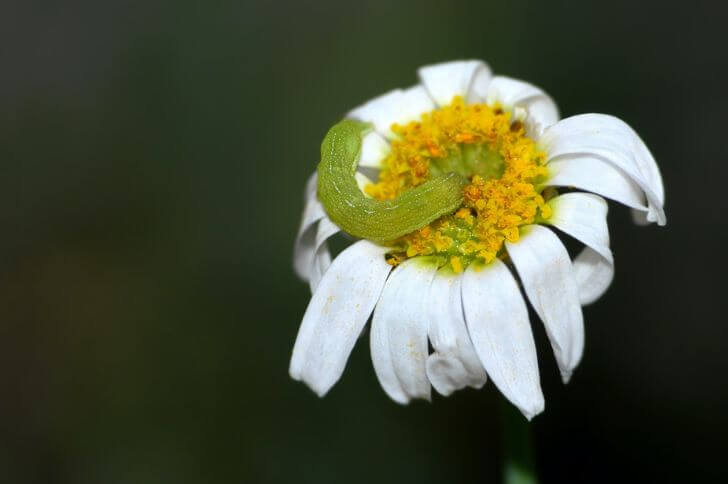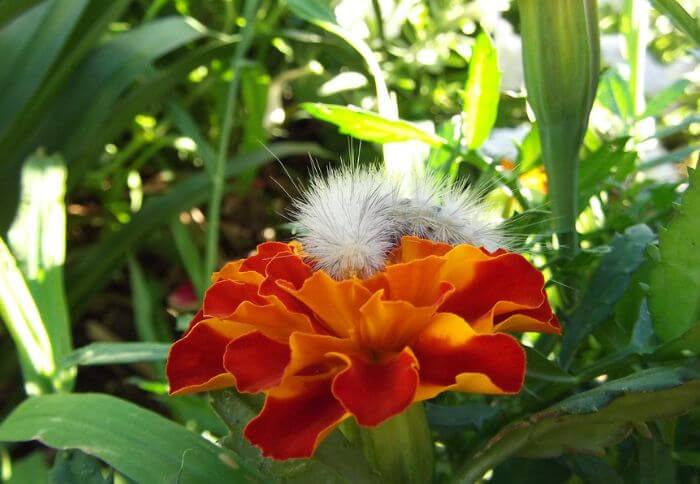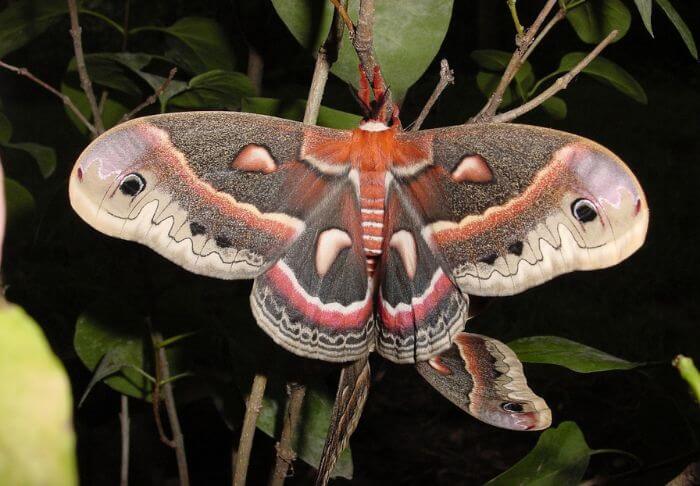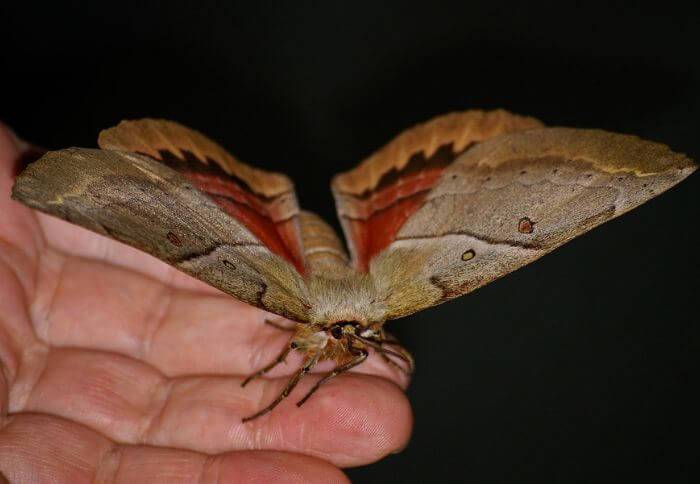15 Green Caterpillars with Yellow (Spots, Stripes & Spikes)
Green caterpillars with yellow spots are no ordinary insects. These vibrant creatures, with their distinctive markings and undulating movements, capture the attention of both children and adults alike.
Found in various regions around the world, these caterpillars boast a remarkable ability to adapt to different environments, making them a fascinating subject of study for scientists and nature enthusiasts.
Their green coloration enables them to blend seamlessly into their leafy surroundings, while the contrasting yellow spots serve as warning signals to potential predators. As we delve deeper into the intriguing world of these unique caterpillars, we uncover not only their captivating appearance but also their remarkable survival strategies and ecological significance.
Green Caterpillars with Yellow (Spots, stripes & spikes)
1. White-lined Sphinx Moth Caterpillar
The white-lined sphinx moth caterpillar is a truly remarkable creature, boasting its distinctive green body adorned with bold yellow lines.
Found in many parts of North America, these caterpillars often go unnoticed due to their excellent camouflage skills. However, upon closer inspection, one can appreciate the intricate patterns and vibrant hues that make them such a fascinating sight.
What sets this caterpillar apart from others is not just its coloration, but also its unique ability to defend itself. When threatened or disturbed, the white-lined sphinx moth caterpillar will rear up and expose the striking red spines along its back.
These spines are not just for show – they contain venomous toxins that can cause irritation or even pain if touched. This clever defense mechanism demonstrates the incredible adaptability and resourcefulness of nature.
Furthermore, it is worth mentioning that the white-lined sphinx moth caterpillar has varied dietary preferences depending on its developmental stage. While younger larvae primarily feed on leaves of plants like tomato or grapevine, older ones become more adventurous and expand their palate to include flowers such as petunias or honeysuckle.
This ability to adapt their feeding habits allows them to thrive in different environments and ensures their survival even when specific food sources may be scarce.
2. Cloudless Sulphur Caterpillar
The cloudless sulphur caterpillar is truly a marvel to behold. With its vibrant green body and striking yellow accents, it manages to stand out even amongst the lush foliage where it thrives.
One of the most fascinating aspects of the cloudless sulphur caterpillar is its ability to camouflage itself in various surroundings.
While their bright colors may initially seem counterintuitive for blending in, they actually help these caterpillars mimic leaves or flowers, depending on their environment. It’s a clever strategy that allows them to avoid predators and seamlessly merge with their surroundings.
In addition to their incredible camouflage skills, cloudless sulphur caterpillars also have an intriguing feeding behavior. Rather than munching on just one type of plant, they are known as generalists, meaning they can consume a variety of host plants.
This adaptability proves advantageous in environments where food sources may be limited or unpredictable. It’s just another example of how these seemingly humble creatures have developed unique ways to not only survive but thrive in their natural habitats.
3. Copper Underwing Caterpillar
The copper underwing caterpillar, with its vibrant green color and striking yellow markings, is a sight to behold in the world of insects. Though often overshadowed by its more well-known counterparts, this unique caterpillar has much to offer in terms of beauty and intrigue.
Its bright coloring serves as a warning to potential predators, signaling that it harbors toxins that are unpalatable or even harmful. This defense mechanism not only helps the copper underwing caterpillar survive but also adds to its allure.
As it grows, the copper underwing caterpillar undergoes several molts, shedding its old skin to reveal a larger and more vibrant body underneath.
With each stage, the yellow markings on its back become more prominent, creating an eye-catching pattern that commands attention. These distinct features serve as a visual cue for predators to avoid consuming this caterpillar—a clear example of evolution at work.
While many people may dismiss insects as inconsequential creatures, taking a closer look at fascinating species like the copper underwing caterpillar can open our eyes to the wonders and intricacies of the natural world.
From their bold colors and patterns to their clever adaptation strategies, these tiny creatures serve as a reminder that there is beauty and complexity even in the most unexpected places.
4. Tiger Swallowtail Caterpillar
One of the most delightful sights in nature is the tiger swallowtail caterpillar. This vibrant green caterpillar, adorned with pops of yellow and black markings, is a true masterpiece that showcases Mother Nature’s creativity.
As it gracefully moves along tree branches, the tiger swallowtail caterpillar captivates onlookers with its striking appearance and enigmatic charm.
What sets this caterpillar apart from others is its ability to transform into a truly majestic creature: the tiger swallowtail butterfly.
This metamorphosis is nothing short of magical and serves as a reminder that beauty can emerge from even the most humble beginnings. As the caterpillar sheds its old skin and enters into its pupal stage, it undergoes a complete transformation, emerging as an elegant butterfly with intricate patterns on its wings.
Beyond their aesthetic appeal, these colorful creatures play an essential role in ecosystems. They are important pollinators, helping to facilitate reproduction among plants by transferring pollen from male to female flower parts. Through this partnership between flowers and butterflies, new life can flourish and thrive in our natural world.
5. Tobacco Hornworm
The tobacco hornworm, also known as the Manduca sexta, is a fascinating creature that can be found in gardens across North America. With its vibrant green color and distinctive yellow markings, it is hard to miss this caterpillar as it munches away on leaves.
One interesting aspect of the tobacco hornworm is its close relationship with plants from the Solanaceae family, including tobacco and tomatoes. While these caterpillars may seem like pests to gardeners, they actually play an important role in pollination as adult moths.
These chubby green caterpillars have a voracious appetite and can quickly strip a plant of its leaves. However, their feeding habits are not entirely detrimental to plants.
In fact, studies have shown that the saliva of the tobacco hornworm contains compounds that may facilitate plant growth by activating defense mechanisms against other insects. This symbiotic relationship between the hornworm and plants highlights the complex web of interactions that exist in nature.
Interestingly, one unique characteristic of the tobacco hornworm is its ability to control its body temperature through behavior rather than relying solely on external sources like sunlight.
When temperatures rise above optimal levels for metabolism or when they need to conserve energy during cool nights, these clever caterpillars will retreat into shaded areas or bask in sunlight respectively. By having this adaptive strategy for thermoregulation, they are able to thrive even in unpredictable environments.
6. Spicebush Swallowtail Caterpillar
The Spicebush swallowtail caterpillar is truly a sight to behold. Its vibrant green body is adorned with striking yellow spots, making it one of the most visually stunning caterpillars in nature. But there’s more to this little creature than meets the eye.
Did you know that the Spicebush swallowtail caterpillar has a unique defense mechanism? When threatened by predators, it extends its osmeterium—an orange, forked appendage that resembles a snake’s tongue—from behind its head.
This act not only startles potential threats but may also emit an unpleasant odor, deterring them from taking any further interest in this feisty critter.
Another interesting fact about these striking caterpillars is their preference for spicebush and sassafras trees as their primary food source.
This narrow dietary selection ensures that they acquire certain chemicals from these plants which not only help them grow and develop but also renders them unpalatable to many would-be predators. It just goes to show that even in the world of insects, sometimes it pays off to be picky eaters!
7. Cecropia Moth Caterpillar
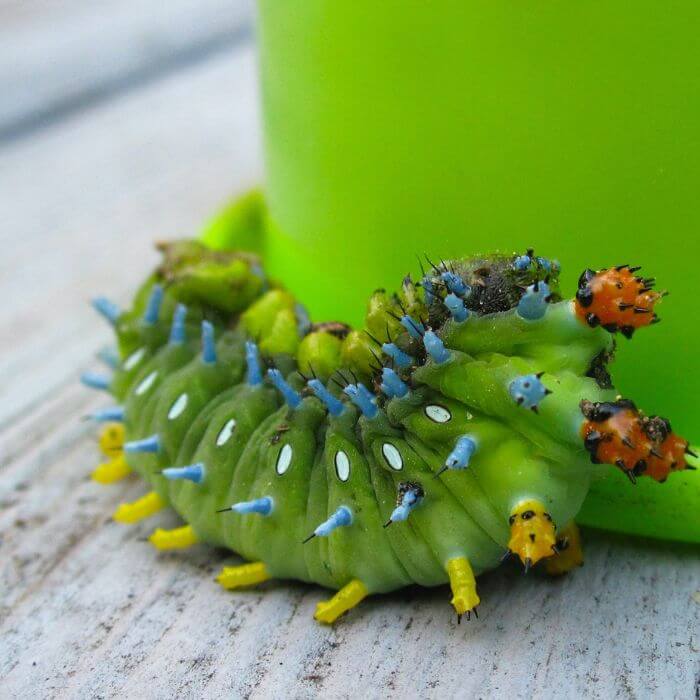
One of the most fascinating creatures you may come across in your garden is the Cecropia moth caterpillar, also known as the Hyalophora cecropia.
This green caterpillar with vibrant yellow spots is a sight to behold and has captured the imagination of many nature enthusiasts. What makes this creature particularly captivating is its size, as it can grow up to four inches long, making it one of North America’s largest native moth species.
But it’s not just their size that makes these caterpillars special; they also display an exquisite pattern of spiny tubercles on their bodies, which serve as a form of defense against predators. These spines might seem intimidating but are harmless to humans.
Moreover, it’s interesting to note that Cecropia moth caterpillars go through five molts before entering the pupal stage, shedding their old skin each time to reveal a brighter and more vibrant appearance.
If you’re lucky enough to spot a Cecropia moth caterpillar in your garden or local park, take some time to observe its behavior closely. You’ll notice that these creatures have a voracious appetite for leaves and can often be found munching away on trees such as maple and cherry.
Despite their conspicuous presence, they do blend well with their surroundings thanks to their green coloration. So next time you see a green caterpillar with vivid yellow spots appear before your eyes, take a moment to appreciate the beauty and uniqueness of nature at work.
8. Spiny Oak Slug Caterpillar
The spiny oak slug caterpillar may appear harmless at first glance with its bold green color and yellow spots, but beneath its deceptive beauty lies a creature equipped with an arsenal of spines.
These spines are not only for show, but also serve as a defense mechanism against potential predators. When threatened, the caterpillar arches its back and raises its spines in a warning display that screams, Don’t mess with me!
In addition to its striking appearance and defensive tactics, the spiny oak slug caterpillar also possesses an interesting feeding habit.
Unlike other caterpillars that feast on leaves using their mandibles, this particular species engulfs entire leaf sections using specialized suction organs located on the bottom of its body.
This method allows it to consume large quantities of plant material efficiently while reducing the need to move around too much.
These distinctive characteristics make the spiny oak slug caterpillar as fascinating as it is unique, reminding us once again of nature’s incredible adaptations.
Whether you encounter one crawling along a tree branch or camouflaging itself amongst foliage, take a moment to appreciate this remarkable creature’s beauty and resilience.
9. Black Swallowtail Caterpillar
The Black Swallowtail caterpillar, with its vibrant black and yellow markings, is a fascinating creature that captivates the attention of nature enthusiasts. This particular species belongs to the Papilionidae family and is commonly found in North America.
What sets this caterpillar apart from others is its unique ability to mimic bird droppings as a defense mechanism against predators. This clever disguise helps them blend seamlessly into their surroundings, making them less likely to be noticed by hungry birds or other potential threats.
As they grow, Black Swallowtail caterpillars undergo several moltings, shedding their old skin to accommodate their increasing size. Each molt reveals new colors and patterns on their body, adding an extra layer of intrigue to this already captivating insect.
With intricate white spots and rows of spiky bristles lining each segment of their body, these young caterpillars are truly a sight to behold.
10. Emperor Moth Caterpillar
Considered one of the most striking caterpillars in the world, the Emperor moth caterpillar possesses a mesmerizing combination of green and yellow hues.
This vibrant coloration serves a practical purpose: to warn predators about its toxicity. The distinct neon-green body is adorned with contrasting yellow stripes that run along its length, creating an eye-catching spectacle in nature.
What makes this particular caterpillar even more fascinating is its ability to mimic snake-like movements when it feels threatened. When disturbed or touched, it arches its head and raises the front part of its body, imitating the movements of a snake prepared to strike.
This display creates a visual illusion that often deters predators from approaching any further. It’s an ingenious survival tactic utilized by this extraordinary creature.
So next time you encounter a green caterpillar with yellow stripes roaming your garden or forest path, take a moment to appreciate the remarkable adaptation and defense mechanisms employed by the Emperor moth caterpillar.
With their vivid colors and deceptive behavior, these enchanting creatures are not only visually captivating but also serve as an inspiring reminder of how evolution has equipped them with exceptional tools for survival in their natural habitat.
11. Luna Moth Caterpillar
The Luna Moth Caterpillar, also known as Actias luna, is a stunning creature that goes through a remarkable transformation. With its vibrant green body and bright yellow spots, this caterpillar species is a true standout in the insect world.
But what makes it even more fascinating is its diet: the Luna Moth Caterpillar exclusively feeds on the leaves of specific trees like birch, sweet gum, and walnut. This specialized diet not only provides necessary nutrients for its growth but also gives it a unique taste that can be detected in its adult moth stage.
As this caterpillar grows bigger, it sheds its skin multiple times during molting stages. Each time it does so, its vibrant coloration becomes even more pronounced and eye-catching.
However, what truly captures our attention are the small spiky bumps running down its back. These spikes are not just for decoration; they act as a defense mechanism against predators by making the caterpillar less appealing to eat.
Intriguingly enough, despite their striking appearance and impressive camouflage skills while searching for suitable resting spots during daytime hours—a behavior often referred to as diurnal hide-and-seek—the pattern on their wings stands out prominently at night.
It’s an enchanting display of nature’s design principles that ensures these beautiful creatures remain safe from potential threats when resting.
12. Imperial Moth Caterpillar
The Imperial moth caterpillar, also known as Eacles imperialis, is a truly fascinating creature. With its vibrant green body adorned with striking yellow markings, this little critter is hard to miss in the wild.
But what makes it even more captivating is its unique ability to change color as it grows and molts.
As a young caterpillar, the Imperial moth sports a bright lime green hue with patches of yellow running along its sides. However, as it matures and develops into adulthood, its appearance undergoes a stunning transformation.
The once bright green color evolves into darker shades of brown or reddish-brown while still retaining those distinctive yellow accents.
Beyond its striking appearance, the Imperial moth caterpillar possesses an intricate defense mechanism. When threatened or disturbed by predators such as birds or lizards, it has the ability to emit loud clicking sounds by flexing its mandibles together rapidly.
This clever strategy startles potential threats and serves as a warning signal that this flashy insect is not one to mess with.
Related Read: Learn about the Luna Moth Caterpillar
13. Dragon-Headed Caterpillar
The dragon-headed caterpillar, also known as the Hornworm, is a fascinating creature that mesmerizes with its vibrant green hue and striking yellow markings.
As it roams through lush foliage, this remarkable insect stands out like a gem amidst a sea of leaves. But there’s more to the dragon-headed caterpillar than meets the eye.
One of the most intriguing aspects of this caterpillar is its peculiar appearance. The horn on its head resembles that of a mythical dragon, hence its name.
This feature not only functions as a defense mechanism but also adds an element of enchantment to these already captivating creatures.
But perhaps what makes the dragon-headed caterpillar truly special is its transformational journey into adulthood. After feeding voraciously on various plants and growing substantially in size, it undergoes metamorphosis and becomes an entirely different being—the magnificent Sphinx moth.
Just like a phoenix rising from the ashes, this once humble caterpillar emerges as an elegant moth adorned with delicate patterns and exquisite colors.
14. Hickory Horned Devil Caterpillar
One of the most fascinating creatures in the insect world is undoubtedly the Hickory Horned Devil caterpillar. With its vibrant green body adorned with yellow accents, this caterpillar is a sight to behold. But its striking appearance is not the only thing that sets it apart from other caterpillars.
The Hickory Horned Devil is one of the largest caterpillars found in North America, measuring up to five inches long. Despite its intimidating size, this creature is harmless and feeds solely on leaves from trees such as hickory and walnut. Its impressive horns may seem menacing, but they are actually soft and pose no threat to humans or animals.
Beyond its appearance, this caterpillar goes through a remarkable transformation before becoming a beautiful moth.
After reaching full size, it descends from the trees and buries itself in the ground to pupate. Several months later, it emerges as a regal Royal Walnut Moth with stunning wings spanning several inches across.
Observing the lifecycle and unique characteristics of the Hickory Horned Devil caterpillar provides us with an awe-inspiring glimpse into nature’s wonders. It serves as a reminder that even within seemingly ordinary creatures, there lies extraordinary beauty waiting to be discovered.
15. Hackberry Emperor Caterpillar
The Hackberry Emperor caterpillar, with its striking green body and vibrant yellow spots, is a fascinating creature that often goes unnoticed in the vast expanse of nature.
As it feasts on the leaves of hackberry trees, this little caterpillar undergoes a miraculous transformation, evolving into a magnificent butterfly. The life cycle of the Hackberry Emperor caterpillar holds within it valuable lessons about adaptation and perseverance.
One intriguing aspect of the Hackberry Emperor caterpillar is its ability to blend seamlessly with its surroundings. Its vibrant green coloration helps camouflage it amongst the lush foliage of hackberry trees, making it difficult for predators to spot.
This remarkable adaptation allows the caterpillar to stay safe while devouring leaves and growing stronger for its ultimate conversion into an elegant butterfly.
Furthermore, the yellow spots that adorn the body of this caterpillar are not merely decorative but serve as warning signs for potential predators.
These bright markings are believed to signal that the Hackberry Emperor caterpillars feed on alkaloid-rich plants which can make them toxic or distasteful. By advertising their unpalatability through their vivid appearance, these clever creatures deter many would-be attackers.
16. Crowned Slug Moth Caterpillar
The crowned slug moth caterpillar (Isa textula) is a fascinating creature that catches the eye with its vibrant green body and striking yellow spots.
Despite its small size, this little caterpillar possesses an incredible defense mechanism – venomous spines that can leave an unforgettable sting. These spines are hidden under clusters of bright yellow bristles, creating a crown-like pattern along its back and giving it its unique name.
While the crowned slug moth caterpillar may seem harmless at first glance, it is important to exercise caution when observing or handling these creatures.
The venomous spines serve as a deterrent against potential predators and can cause severe pain and irritation in humans. This serves as a reminder of how appearances can be deceiving in nature – even the most seemingly harmless creatures can have hidden secrets.
In addition to their stunning appearance and formidable defense mechanism, crowned slug moth caterpillars undergo a remarkable transformation during their lifecycle.
Once they reach maturity, they spin dense cocoons to protect themselves as they transform into beautiful adult moths. These moths typically emerge in shades of red or orange – an astonishing contrast to their brilliant green larvae form.
Final Thoughts
In conclusion, there are several types of green caterpillars with yellow markings that can be found in various habitats around the world. These caterpillars possess unique characteristics and behaviors that make them fascinating creatures to observe.
From the striking appearance of the tobacco hornworm to the delicate beauty of the lime hawk moth caterpillar, each species has its own allure. Learning about these colorful caterpillars not only deepens our understanding of biodiversity but also encourages us to appreciate the wonders of nature.
So next time you come across a green caterpillar with yellow markings, take a moment to marvel at its remarkable features and remember the important role it plays in our ecosystem.
source:

Passionate animal enthusiast and skilled writer with a flair for captivating storytelling. With over five years of experience, I have crafted engaging content that sheds light on the fascinating world of animals.
Through my articles, blog posts, and social media campaigns, I strive to raise awareness about conservation efforts and promote a deeper understanding of the natural world.
